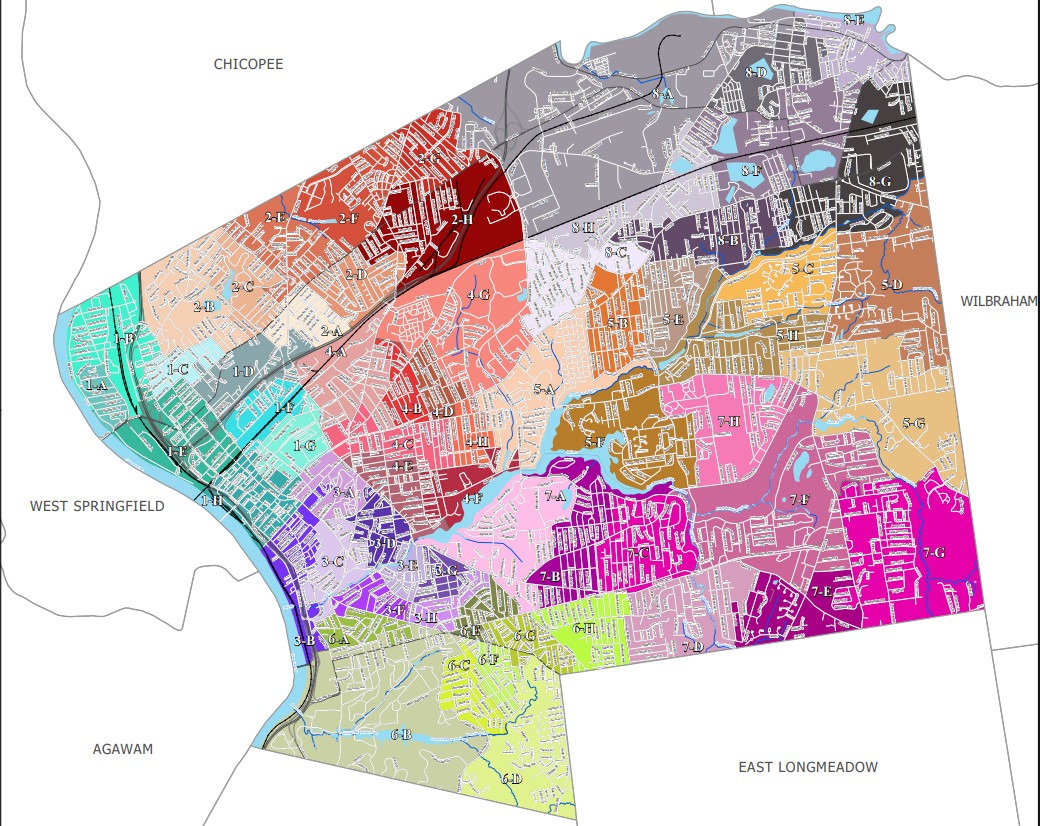Briefings: Mapmaker, Mapmaker Make Springfield a Map…
UPDATE: The Springfield City Council has approved the new maps Tuesday.

…precinct a precinct. Award it a ward. Ward 1 (blues), Ward 2 (orange-reds), Ward 3 (dark purples) Ward 4 (pink-reds) Ward 5 (browns) Ward 6 (greens) Ward 7 (hot pinks) Ward 8 (greys). (via Springfield Election Commission)
While the Massachusetts legislature lumbers through its own district maps for the next ten years, the same process is playing out on the municipal level. Municipalities needs to redraw precincts and local electoral districts to be of roughly equal population. At least partly because Census data was delayed, Beacon Hill controversially went first, drawing its maps before municipalities reset precincts.
That sparked concerns about a bureaucratic nightmare in some cities and towns. Potentially, residents in the same precincts could need different ballots. Other cities may still experience that, but it will not happen in Springfield. Its new precinct boundaries will conform to the state’s new legislative districts. Wards and precincts are changing only slightly as the city’s population was largely stable. A new map goes before the Council Tuesday.
“We had our numbers and projections before [the legislature] even started maps on our end so we had an idea of how we would do locally,” said Springfield City Clerk Gladys Oyola-Lopez, who also oversees the Election Commission.
In Springfield, the Election Commission oversees re-precincting and by extension redrawing of wards. The task has happened for time immemorial but was a pro forma exercise before ward representation returned in 2009. With one councilor from each of the eight wards and four School Committee members from districts of two wards each, the exact shapes of wards has political salience.
While the Council will see the map Tuesday, the election next month will occur under the maps the Council approved 10 years ago. The first city election under the new maps will be in 2023. However, the precincts would be effective for next year’s state election.

The 2011 map remains in effect for the 2021 Council & School Committee elections. (via Springfield Election Commission)
Oyola-Lopez said no major shifts that required complex changes, a departure from 10 years ago. Despite the growth in the Latino population, there was no real impetus to erect another minority-majority district either. Six of the eight ward councilors are persons of color. Rather, Hispanic population growth was fairly uniform citywide she said.
An examination of the shifting precinct lines mostly confirms Oyola-Lopez’s assessment. The edges of precincts shift from by a few blocks or even half a block. For example, the old Highland Railway no longer forms a border between Ward 6 and 7. Two precincts in Ward 8 swap a chunk of land near Pine Point. Elsewhere, a few lines among precinct and wards look a bit clearer.
Although more Latinos are now living everywhere in the city, she said Springfield’s overall increase in population was somewhat concentrated in the northwest. Wards 1 and 2 meet there and probably share the more complex changes and zigzags in the new map. An early version accounting for this growth could have had the effect of diluting minority representation.
“When I saw the initial map, it made a big change in the Ward 1 area,” she said. It would have crept up the hill into Atwater where Ward 2 City Councilor Michael Fenton and Congressman Richard Neal live.
Yet, the effect of adding Atwater to largely Latino Ward 1, due to turnout dynamics, would dilute minority voices. Higher turnout in Atwater, the Mattoon Street area and Classical Condominiums, whose populations are whiter, would likely drive who wins the seat. Turnout in Ward 2, meanwhile, would still favor whiter populations.
“That right there would create a problem keeping minority representation in that district,” she said. Instead, the Atwater precinct shifted but remained in Ward 2. The maps reshuffled Ward 1’s precincts somewhat, but minority populations will remain the dominant force in that ward’s Council election.
As for the state going first this time, Oyola-Lopez said that it ended up being more straightforward than in 2011. As the legislature gallivanted across the state for public input, the Election Commission was reviewing data and communicating with Secretary of the Commonwealth Bill Galvin’s office. (The Secretary is the state’s US Census liaison).
“Thankfully for Springfield, we have kept very close to what we had before and it keeps the same spirt of ward representation for at least another ten years,” she said. “It’s been strangely simple.”
